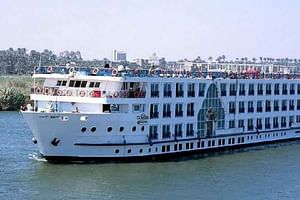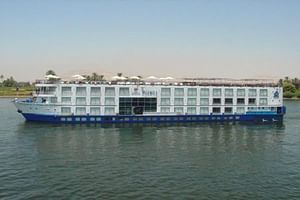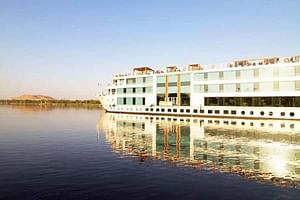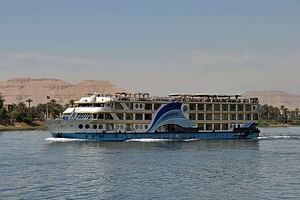continue to visit the Egyptian museum and Khan el Khalili.
continue to visit Egyptian museum over there you can see collections of Tut Ankh Amon, enjoy your lunch continue to visit Khan el Khalili area which consider the oldest market in the middle east.
continue to visit Egyptian museum over there you can see collections of Tut Ankh Amon, enjoy your lunch continue to visit Khan el Khalili area which consider the oldest market in the middle east.
Day 3
Memphis
visit Memphis the oldest capital of ancient Egyptian time.
After breakfast, we will pick you up to visit Memphis the oldest capital of ancient Egyptian time and see the open-air museum there.
According to legend, as related by Manetho, the city of <...
After breakfast, we will pick you up to visit Memphis the oldest capital of ancient Egyptian time and see the open-air museum there.
According to legend, as related by Manetho, the city of Memphis was founded by the Pharaoh Menes. It was the Capital of ancient Egypt during the Old Kingdom and remained an important city throughout ancient Egyptian history.
Memphis was believed to be under the protection of the god Ptah, the patron of craftsmen. Its great temple, Hut-ka-Ptah (meaning "Enclosure of the ka of Ptah"), was one of the most prominent structures in the city.
Day 3
Saqqara
Visit the Saqqara step pyramid (The Pyramid of Djoser)
visit Saqqara step pyramid of king Zoser (The
visit Saqqara step pyramid of king Zoser (The Pyramid of Djoser)
The Pyramid of Djoser (or Djoser and Zoser) or Step Pyramid is an archaeological remain in the Saqqara necropolis, Egypt, northwest of the city of Memphis. The 6-tier, 4-sided structure is the earliest colossal stone building in Egypt.
It was built in the 27th century BC during the Third Dynasty for the burial of Pharaoh Djoser by his vizier, Imhotep. The pyramid is the central feature of a vast mortuary complex in an enormous courtyard surrounded by ceremonial structures and decoration.
Day 3
Dahshour
continue to Dahshour.
continue to Dahshour to see the unique pyramid of Senfro “bent pyramid”.
Dahshour is a royal necropolis located in the desert on the west bank of the Nile approximately 40 kilometres (25...
continue to Dahshour to see the unique pyramid of Senfro “bent pyramid”.
Dahshour is a royal necropolis located in the desert on the west bank of the Nile approximately 40 kilometres (25 mi) south of Cairo. It is known chiefly for several pyramids, two of which are among the oldest, largest and best-preserved in Egypt, built from 2613–2589 BC.
The Dahshur pyramids were an extremely important learning experience for the Egyptians. It provided them with the knowledge and know-how to transition from steep-sided pyramids to smooth-sided pyramids. Ultimately their breadth of experience would allow them to build the Great Pyramid of Giza; the last of the Seven Wonders of the Ancient World still standing to this date.
Day 4
Fly to Aswan
Fly to Aswan
After breakfast you will check out and our representative will escort you to Cairo airport for your flight to Aswan.
After breakfast you will check out and our representative will escort you to Cairo airport for your flight to Aswan.
Day 4
Aswan Nile Cruise embarkation
Aswan Nile Cruise
our representative will wait and assist you at Aswan airport and check in your cruise embarkation before lunch.
our representative will wait and assist you at Aswan airport and check in your cruise embarkation before lunch.
Day 4
Aswan High Dam
start your tour to visit Aswan High Dam
start your tour to visit Aswan High Dam
The Aswan Dam, or more specifically since the 1960s, the Aswan High Dam, is an embankment dam built across the Nile in Aswan, Egypt, between 1960 and ...
start your tour to visit Aswan High Dam
The Aswan Dam, or more specifically since the 1960s, the Aswan High Dam, is an embankment dam built across the Nile in Aswan, Egypt, between 1960 and 1970. Its significance largely eclipsed the previous Aswan Low Dam initially completed in 1902 downstream. Based on the success of the Low Dam, then at its maximum utilization, construction of the High Dam became a key objective of the government following the Egyptian Revolution of 1952; with its ability to better control flooding, provide increased water storage for irrigation and generate hydroelectricity the dam was seen as pivotal to Egypt's planned industrialization. Like the earlier implementation, the High Dam has had a significant effect on the economy and culture of Egypt.
Day 4
Philae temple
visit Philae temple by motorboat.
visit Philae temple by motor boat where the temple located in Agilika Island.
Philae was originally located near the expansive First Catara...
visit Philae temple by motor boat where the temple located in Agilika Island.
Philae was originally located near the expansive First Cataract of the Nile in Upper Egypt and was the site of an Egyptian temple complex. These rapids and the surrounding area have been variously flooded since the initial construction of the Aswan Low Dam in 1902. The temple complex was dismantled and moved to nearby Agilkia Island as part of the UNESCO Nubia Campaign project, protecting this and other complexes before the 1970 completion of the Aswan High Dam.
Day 5
Kom Ombo
After breakfast start sailing to visit Kom Ombo temple which consider the only double temple in Egypt.
After breakfast start sailing to visit Kom Ombo temple which consider the only double temple in Egypt.
The Temple of Kom Ombo is an unusual double temple in the town of Kom Ombo in Aswan Gov...
After breakfast start sailing to visit Kom Ombo temple which consider the only double temple in Egypt.
The Temple of Kom Ombo is an unusual double temple in the town of Kom Ombo in Aswan Governorate, Upper Egypt. It was constructed during the Ptolemaic dynasty, 180–47 BC. Some additions to it were later made during the Roman period. The building is unique because its 'double' design meant that there were courts, halls, sanctuaries and rooms duplicated for two sets of gods
Day 5
Edfu
sailing to Edfu after lunch visit the most preserved temple in Egypt “Horus temple”
sailing to Edfu after lunch visit the most preserved temple in Egypt “Horus temple”
The Temple of Edfu is an Egyptian temple located on the west bank of the Nile in Edfu, Upper Egypt. Th...
sailing to Edfu after lunch visit the most preserved temple in Egypt “Horus temple”
The Temple of Edfu is an Egyptian temple located on the west bank of the Nile in Edfu, Upper Egypt. The city was known in the Hellenistic period as Koinē Greek: Ἀπόλλωνος πόλις and Latin Apollonopolis Magna, after the chief god Horus, who was identified as Apollo under the interpretation Graeca.
It is one of the best-preserved shrines in Egypt. The temple was built in the Ptolemaic Kingdom between 237 and 57 BC. The inscriptions on its walls provide important information on language, myth and religion during the Hellenistic period in Egypt.
Day 5
sailing to Esna
sailing to Esna crossing Esna lock.
sailing to Esna then cross Esna lock, sailing to Luxor for overnight.
sailing to Esna then cross Esna lock, sailing to Luxor for overnight.
Day 6
Valley of the Kings
After breakfast visit west bank of Luxor, Valley of the Kings.
After breakfast visit west bank of Luxor, Valley of the Kings.
The Valley of the Kings, also known as the Valley of the Gates of the Kings, it is a valley in Egypt for a period of nearly 500...
After breakfast visit west bank of Luxor, Valley of the Kings.
The Valley of the Kings, also known as the Valley of the Gates of the Kings, it is a valley in Egypt for a period of nearly 500 years from the 16th to 11th century BC, rock-cut tombs were excavated for the pharaohs and powerful nobles of the New Kingdom (the Eighteenth to the Twentieth Dynasties of Ancient Egypt).
Day 6
Queen Hatshepsut temple
Visit Queen Hatshepsut temple in West Bank
Queen Hatshepsut temple
The Mortuary Temple of ...
Queen Hatshepsut temple
The Mortuary Temple of Hatshepsut, also known as the Djoser-Djeseru, is a mortuary
temple of Ancient Egypt located in Upper Egypt. Built for the Eighteenth
Dynasty pharaoh Hatshepsut, it is located beneath the cliffs at Deir el-Bahari
on the west bank of the Nile near the Valley of the Kings. This mortuary temple
is dedicated to Amun and Hatshepsut and is situated next to the mortuary temple
of Mentuhotep II, which served both as an inspiration and later, a quarry. It
is considered one of the "incomparable monuments of ancient Egypt."
Day 6
Colossi of Memnon
The Colossi of Memnon are two massive stone statues of the Pharaoh Amenhotep III.
The Colossi of Memnon are two massive stone statues of the Pharaoh Amenhotep III,
who reigned in Egypt during the Dynasty XVIII. Since 1...
The Colossi of Memnon are two massive stone statues of the Pharaoh Amenhotep III,
who reigned in Egypt during the Dynasty XVIII. Since 1350 BCE, they have stood
in the Theban Necropolis, located west of the River Nile from the modern city
of Luxor.
Day 7
The Karnak Temple Complex
Visit Karnak Temple Complex.
The Karnak Temple Complex, commonly known as Karnak, comprises a vast mix of decayed temples, chapels, pylons, and other buildings near Luxor, in Egypt. Construction at the complex...
The Karnak Temple Complex, commonly known as Karnak, comprises a vast mix of decayed temples, chapels, pylons, and other buildings near Luxor, in Egypt. Construction at the complex began during the reign of Senusret I in the Middle Kingdom and continued into the Ptolemaic period, although most of the extant buildings date from the New Kingdom. The area around Karnak was the ancient Egyptian Ipet-isut ("The Most Selected of Places") and the main place of worship of the eighteenth dynasty Theban Triad with the god Amun as its head. It is part of the monumental city of Thebes. The Karnak complex gives its name to the nearby, and partly surrounded, modern village of El-Karnak, 2.5 kilometres (1.6 miles) north of Luxor.
Day 7
Luxor temple
Visit Luxor temple.
Luxor Temple is a large Ancient Egyptian temple complex located on the east bank of the Nile River in the city today known as Luxor (ancient Thebes) and was constructed approximate...
Luxor Temple is a large Ancient Egyptian temple complex located on the east bank of the Nile River in the city today known as Luxor (ancient Thebes) and was constructed approximately 1400 BCE. In the Egyptian language, it is known as "ipet resyt", "the southern sanctuary".
In Luxor, there are several great temples on the east and west banks. Four of the major mortuary temples visited by early travellers and tourists include the Temple of Seti I at Gurnah, the Temple of Hatshepsut at Deir el Bahri, the Temple of Ramesses II (a.k.a. Ramesseum), and the Temple of Ramesses III at Medinet Habu; the two primary cults temples on the east bank are known as the Karnak and Luxor.
Day 7
overnight Luxor
check-in to your hotel overnight Luxor.
check-in to your hotel overnight Luxor.
check-in to your hotel overnight Luxor.
Day 8
Luxor optional tours, fly to Cairo
a free day in Luxor city which has 1/3 of ancient monuments in the world, and fly to Cairo.
After breakfast, you will have a free day in Luxor city which has 1/3 of ancient monuments in the world. You can choose from a variety of optional tours.
then you will be transferred to Luxo...
After breakfast, you will have a free day in Luxor city which has 1/3 of ancient monuments in the world. You can choose from a variety of optional tours.
then you will be transferred to Luxor airport to fly to Cairo.
Day 8
Cairo free day
Cairo overnight
Our representative will assist and meet you at Cairo airport and drop you off at your hotel You will have the rest of the day in Cairo to do as you prefer.
Our representative will assist and meet you at Cairo airport and drop you off at your hotel You will have the rest of the day in Cairo to do as you prefer.
Day 9
Final departure
Final departure: check out from the hotel then transfer to Cairo airport.
Final departure: check out from the hotel then transfer to Cairo airport.















